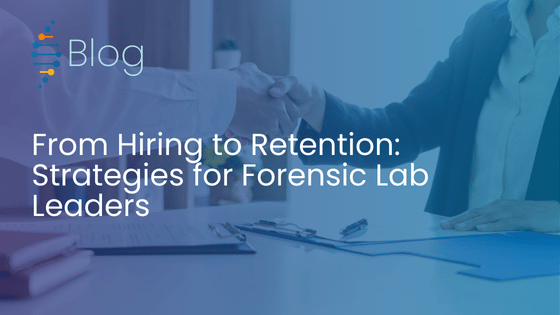Interviews written and collated by Tara Luther, Promega. Reposted from the ISHI Report with permission.
In the dynamic world of forensic science, shaping the future of our labs and the professionals who work in them is more crucial than ever. We had the privilege of sitting down with Ray Wickenheiser, John Collins, Pam Marshall, and Julie Sikorsky, who are leading the “Building the Forensic Scientist Pipeline” workshop at this year’s ISHI conference. These industry leaders shared their valuable insights on job satisfaction, effective management practices, professional development, and the integration of new technologies. Their collective wisdom provides a roadmap for creating a thriving forensic workforce.

What are the key factors that contribute to job satisfaction and retention among DNA analysts in forensic labs?
Ray Wickenheiser, Retired Director for the New York State Police Crime Lab System:
There are 3 key factors for job satisfaction and retention for DNA analysts at forensic laboratories. These are appreciation, inclusion and mission. We know that our talented DNA folks could make more money elsewhere, but they enjoy working in forensic laboratories due to our phenomenal mission of helping people obtain justice, public safety and protect individuals’ rights with our analysts’ application of forensic science to their cases. However, that mission can get lost in the rigors of our day-to-day flurry of activity, so reinforcing that compelling forensic mission with our analysts, along with appreciation for their contribution and including them in decision making, planning and strategy are key factors to job satisfaction. A satisfied DNA champion who is recognized and appreciated will likely stay with us.
Can you identify common management practices in forensic labs that positively or negatively impact analyst retention?
John Collins, High-Stakes Leadership Consultant and Executive Coach at Critical Victories
We have to keep in mind that employees have more access to career options than they did 20 or 30 years ago, mainly because of the internet and the ability to find and apply for jobs. That means they are far less willing to tolerate frustrations. Frustration is the predictor of departure, while the lack of frustration predicts retention. Management practices driven by leaders who are principled, clear and generous in their communications, and whose actions and decisions are consistent with their stated principles or values tend to be highly respected and far less likely to frustrate their employees. It’s the difficult-to-figure-out managers who don’t seem to stand for anything meaningful and don’t seem to care, one way or the other, who chronically frustrate their employees. So, management practices that encourage and reward loyalty to a core set of principles and values are more likely to draw employees in rather than push them away. It then becomes obvious that employee retention is primarily driven by organizational efforts to ensure that high-quality people are placed in positions of leadership, and that less-competent influencers in the organization are kept out of the way. This is the kind of organization that people want to work in and tend to stay in.
What role does professional development play in retaining analysts, and how should it be implemented by lab supervisors?
Pam Marshall, Director, Duquesne University
Retaining top talent is critical to keeping a laboratory on the right track, especially in a competitive job market like forensic science. A key strategy for improving retention among analysts is through the implementation of learning and development programs. According to a recent Gallup survey, 66% of workers ranked professional development opportunities as one of the top three benefits they look for in an employer. So not only is PD a way to retain high quality analysts, it’s also a way to recruit them!!
Analysts feel valued when they are given opportunities to grow and develop their skills, yielding an increase in their motivation and loyalty to an organization, creating a win-win scenario for both the lab and its employees. Developing a positive work environment helps the analysts feel supported and empowered to reach their full potential.
Laboratory supervisors should first assess the needs of their unit and employees (an example would be a survey so the analysts have a voice). Secondly, the supervisor should ensure a variety of learning opportunities-making sure to offer a mix of in-person, online, workshops, conferences, or mentorship programs can ensure that all analysts can find the right training to help them at the right time. Lastly, a supervisor should encourage and create a culture of continuous learning. This can be done by promoting autonomous learning, sharing amongst their team, and providing resources that have benefitted them on their path to leadership.

Given the rapid technological advancements in forensic science, how can supervisors effectively manage the integration of new technologies while ensuring the team remains adaptable and motivated?
Julie Sikorsky, Forensic Scientist Supervisor, Palm Beach County Sheriff’s Office
Decrease surprise and make the team a change partner. As soon as you think a change may be coming or if you begin looking to implement something new, begin a conversation with the team. Give them an opportunity to get used to the idea. Increase buy-in by involving team members in the research/ benchmarking/ validation needed for the potential technology. Have them (vs. management/ TL) present to the entire staff, effectively “selling” it to their fellow team members. The result will be a more resilient, more satisfied team that was part of the change and not a “victim” of it.
How can leaders in forensic labs effectively communicate the value and impact of an analyst's work to enhance job satisfaction and retention?
Pam Marshall, Director, Duquesne University
Effective communication enables leaders to convey needs for adaptation, share new ideas, and encourage a culture that values the impact of their work. Leaders should set clear and realistic expectations from the first date of hire, and should also provide timely feedback, guidance, and support along the way. Of note is the word “timely” – this is an important concept so that an analyst can make improvements or can get feedback immediately as tasks are completed. It is also important to articulate why their work has meaning, finding ways of showing how their work affects their community or the criminal justice system as a whole. This will ultimately enhance an analysts’ knowledge, skills, and motivation, contributing to higher performance levels. Overall, leaders who effectively communicate (and actively listen) with their teams will also see improved job satisfaction and employee engagement, yielding a higher percentage of retention.
What strategies can supervisors employ to handle conflicts or challenges that might lead to analyst turnover?
Julie Sikorsky, Forensic Scientist Supervisor, Palm Beach County Sheriff’s Office
Communication, communication, communication. If at all possible, prevent the conflicts/ challenges in the first place by fostering an environment of open and safe communication. Make sure you (the supervisor) are checking in with your team regularly (not having time is an excuse; you don’t have time not to check in). Don’t assume that because you are not hearing from someone everything is status quo. Ask them how they are doing, what they would change if they could, and what their aspirations are. Make sure that you are approachable (be vulnerable) – willing and able to have honest (and hard) conversations with the team. Keep your emotional responses in check and remember to put yourself in their shoes – what would you want/ how would you feel if you were in their position(s)?
How important is the work-life balance for DNA analysts, and what practical steps can supervisors take to support it in a demanding field like forensic science?
Ray Wickenheiser, Retired Director for the New York State Police Crime Lab System
Maintaining work-life balance is critical for a long and satisfying career in forensic DNA. None of us works all the time, nor should we. Satisfaction with life is all about finding balance, and obtaining joy in all aspects of our life, particularly beyond work. We may obtain great value from our work, however if that comes at the expense of family and health, something has got to give and potentially suffer, including our work. Therefore, as supervisors, we must strive to pay attention to the entirety of our employees’ needs beyond that of work for them to be at their best and bring that best self to work each day.
Practical steps supervisors can take include looking after themselves not only for their own health but to provide a good example, setting realistic and achievable goals in partnership with employees, and emphasizing outside interests with family and health at the core. Spending a little time on team building, fun and inclusive exercises, and recognizing with employees the importance of their whole person, builds an expectation of prioritizing and balancing non-work pursuits. Work is a vital part of DNA analysts’ lives, but only one of many sources of joy and satisfaction. With a supervisor’s leadership example of normalizing work-life balance, DNA analysts will be better able to perform and enjoy that performance for an entire fulfilling career.

